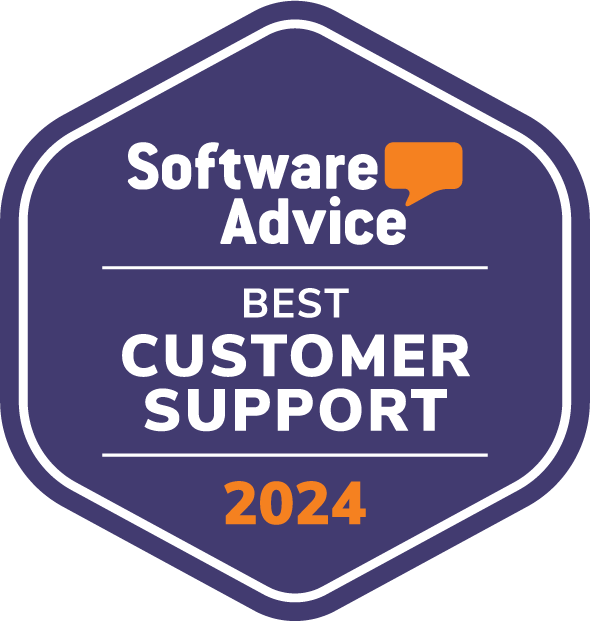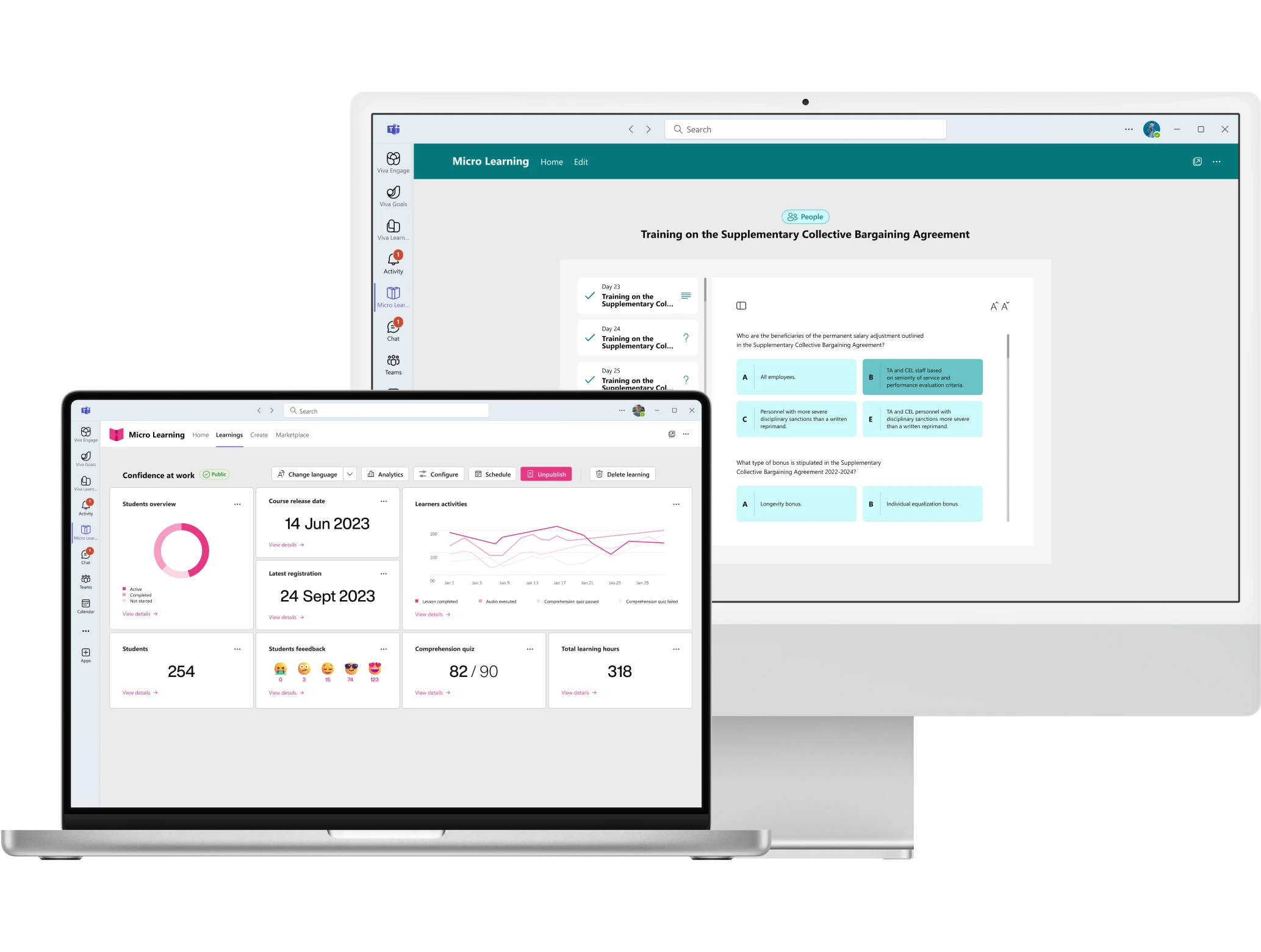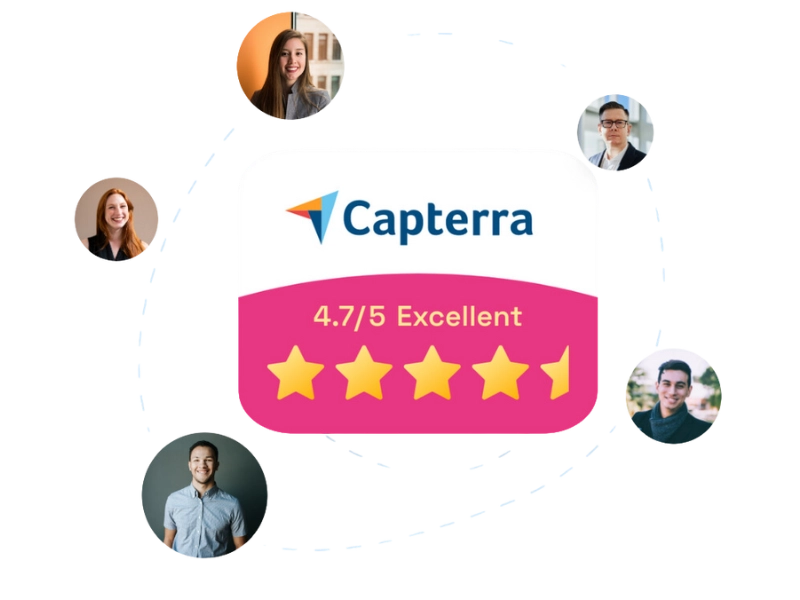What Is Microlearning and How to Bring It in Your Company
Microlearning simplifies the assimilation of content and the retention of knowledge over time, thanks to short and flexible learning units.
In this article, we will look at what microlearning is and how to use it to create a more engaging training experience.
We will also talk about our Microlearning platform, designed to turn business procedures into complete training courses with the support of artificial intelligence.
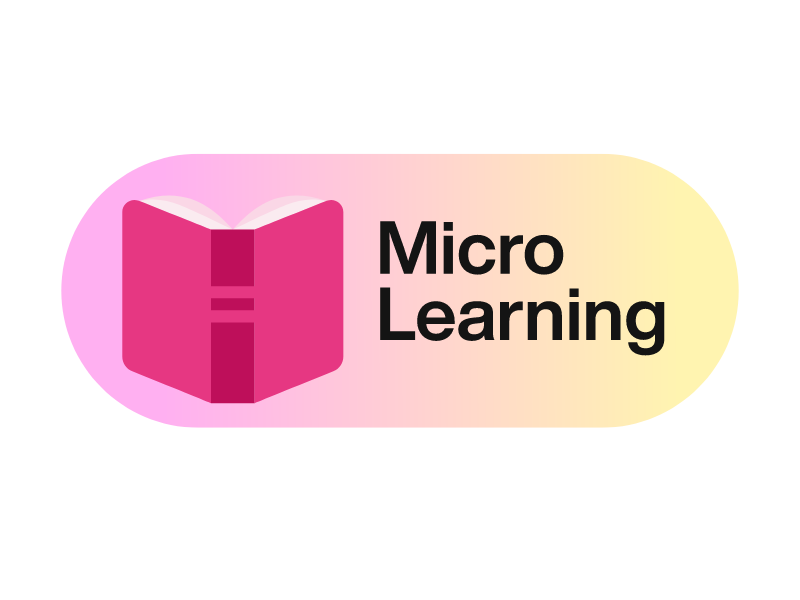
What is microlearning
Although there is no official definition of microlearning, this term can be used to refer to any type of learning resource that is:
- Short, lasting only a few minutes
- Digital, accessible from desktop or mobile devices
Microlearning is essentially a methodology based on offering small learning units and short educational activities to help users absorb information with minimal effort.
The content that can be created in microlearning format can take many forms. Generally, a micro-lesson corresponds to:
- A video
- An audio clip
- A paragraph of text
- An illustration or infographic
- An interactive element such as a test, quiz, flash card, or challenge
Thanks to this variety, microlearning courses can maintain participants’ attention and meet their individual learning needs. It is important to remember that only about 60% of people are visual learners, while the remaining 40% are divided into kinesthetic learners, who learn by doing, and auditory learners.
Courses based solely on textual content or long presentations therefore yield mediocre results, especially when lessons are made up of overly complex paragraphs or decks with too many slides. If the training is aimed at a corporate audience, where time and energy are limited, the outcomes are even worse.
In the case of companies, the usefulness of traditional lessons drastically decreases due to the need to train employees on procedures and tasks that are often complex, unfamiliar, and not very engaging to teach through long informational pages or a series of hour-long videos.
Microlearning is the alternative solution to traditional training courses, delivering the most promising results both in terms of learning and long-term retention of information. It also adapts to a wide variety of contexts, such as:
- Employee training
- Vertical training for individual departments
- Health and safety training
- Onboarding training for new colleagues
Whatever the training need, users have the opportunity to spend less than 10 minutes to acquire the knowledge and develop the skills needed for their job. They can use micro-lessons to reinforce the concepts learned, completing end-of-module tests and quizzes in just a few minutes from any device—perhaps prepared specifically by the company.
Microlearning can therefore be defined as the most flexible, practical, and convenient learning methodology—even compared to the e-learning approach we have become accustomed to until now.
Microlearning: How to turn documents into interactive courses
What is the difference between e-learning and microlearning
E-learning and microlearning are the most popular and appreciated learning methods, reducing physical and time constraints in training. These two approaches share several features—so many, in fact, that they are often confused with each other.
Both e-learning and microlearning allow learners to:
- Gain new knowledge and skills remotely
- Learn through various formats, such as text, video, and audio
- Access digital informational resources, sometimes directly from the internet
Even though the two terms are sometimes used interchangeably, microlearning is actually a modular approach to training, where information is divided into short and concise learning units. In contrast, e-learning courses often feature content-rich lessons that differ from traditional in-person classes mainly in format.
E-learning courses are designed to provide a deep understanding of a topic through a structured educational path, offering users a broad knowledge base. Lessons follow a linear sequence, alternating between text content, videos, and audio tracks.
Microlearning courses, on the other hand, offer small-sized modules focused on specific learning objectives. Each module is created to deliver just the right amount of information to understand the topic and apply it immediately. That’s why this method is especially suited to professionals and companies with limited time and energy for training.
In general, microlearning is the ideal solution for those seeking more flexibility, have targeted learning goals, or want to quickly close skill gaps.
To maximize the benefits of both approaches, the best strategy is to combine the global and structured vision of e-learning with the practicality and effectiveness of microlearning.
E-learning courses can be used as the foundation for training, while microlearning modules can be integrated to more easily grasp key concepts and reinforce learning over time.

What are the benefits of microlearning
It is now essential for companies to create a training experience capable of engaging employees, through learning paths that are easy to absorb and put into practice.
In today’s professional context, traditional long-term training programs are often unsuitable for the needs of companies, which require a more flexible and targeted learning method. Microlearning is enjoying significant success because it allows training to be managed within the limited time available to workers, providing them with the key information to quickly develop their skills.
Short and multimedia content, interactive quizzes, gamified experiences, and fast access from any device make microlearning courses the ideal tool to support users in their training throughout intense workdays. Furthermore, it has been shown that the retention rate of learned information increases from 10-20% to about 90% more than 3 days after completing the corresponding learning units.
Let’s briefly look at the features of microlearning that enable companies and professionals to achieve these ambitious results.
Agile training
As the name suggests, the microlearning methodology focuses on the creation and distribution of small amounts of information to simplify their assimilation and retention.
Micro-lessons can be easily slotted in between tasks, to avoid long interruptions in the workflow and to make the most of the available time and attention. Each user can complete short learning modules focused on specific topics, accompanied by quick tests to immediately apply the newly acquired knowledge.
Even reviewing key concepts becomes easier thanks to quizzes and special formats such as flashcards. In just a few minutes, users can answer targeted questions and receive a concise response with useful details to remember in order to:
- Handle a complex procedure
- Improve the use of business software
- Enhance communication with colleagues and clients
- Deepen the understanding of a new product’s features
- Tackle technical or managerial issues
Thanks to short content and constant practice, people can finally learn new skills quickly and efficiently. For this reason, microlearning methodology is an opportunity to invest in training without compromising daily productivity.
Personalized training
Microlearning courses are easy to create, quick to distribute, and effective to learn. But there’s more.
The brevity of content offers the great advantage of adapting training to the constantly evolving needs of professionals and businesses, with minimal investment of time and resources. Micro-lessons can therefore be customized to fill urgent gaps or to provide updates on relevant topics when they are most needed for business growth.
Microlearning also makes it possible to meet the specific learning needs of people in the company, addressing their requests in terms of accessibility, level of detail, content format, and lesson duration.
The advanced level of customization and the convenience of content production make internal training a targeted and scalable process, especially in large organizations that require continuous staff commitment to develop their industry-specific skills and knowledge.
Engaging training
Concept synthesis and lesson personalization make microlearning one of the most engaging learning methodologies in digital training.
It is indeed difficult to maintain the attention of a user audience with content that is long, complex, not very interactive, and not focused on their real needs, both practical and communicative. In a business context, this presents a serious compliance risk if procedures are not understood or tasks are not performed correctly.
As we have seen, microlearning overcomes these challenges by offering more engaging learning paths through:
- Lessons shorter than 10 minutes
- Multimedia content combining text, video, and audio
- Gamification experiences such as quizzes, flashcards, and timed challenges
Another key element to keeping users engaged is adaptability, as microlearning courses can be accessed at one’s own pace, from any device, and at any time of day. This approach aims to combine professional growth with the worker’s available time, without requiring sacrifices in productivity or quality of life.
Short and engaging training
Besides implementing your intranet project with minimal investment, we offer additional tools to enrich your digital workplace and enhance the employee experience.
Microlearning is the platform we have created to support corporate training. It is based on generative AI and integration with Microsoft 365 Copilot to:
- Generate courses from company documents
- Translate content into 40+ languages in a few seconds
- Manage training through course assignment and progress tracking
How to create corporate courses with microlearning
Although microlearning courses are simpler and more cost-effective to create than traditional training formats, it’s important to know a few best practices to make the most of the benefits offered by micro-lessons, as we’ve seen in this article.
Below are some tips to make training more agile and effective thanks to microlearning.
Filtering the information
It is essential that micro-lessons do not exceed 5/10 minutes.
This is because the power of microlearning lies in the brevity of the content, which can be more easily absorbed and remembered.
When creating your micro-lessons, you should therefore select the information to share with users in order to maximize the available time and attention.
To do so, you can follow these few simple steps:
- Identify the learning objectives
- Break down the topic into key concepts
- Prioritize practical information
- Group the concepts into thematic units
A final step involves gathering feedback to understand whether and how the course should be adjusted to provide users with the most useful information for their work.

Alternating multimedia content
Users will quickly get tired of reading only textual explanations, even if they’re short.
The flexibility of microlearning makes it possible to diversify training courses, keeping attention high and making learning easier through:
- Animations
- Video presentations
- Podcast-style audio clips
- Images, carousels, and infographics
Diversifying the content of a course—especially in microlearning format—allows you to reach an information retention rate of up to 90%. In addition to encouraging colleagues to continue training consistently, lesson after lesson, to discover new video tutorials, expert interviews, discussions, short audio guides, animated graphics, and more.
Training becomes as engaging as the experience on social media, without investing too much time and resources to achieve the same communication impact and ease of use.

Including gamification experiences
How can you keep users’ attention without engaging them?
Corporate courses should always include interactive elements such as quizzes and tests, but also:
- timed challenges
- problem-solving exercises
- simulations of use cases or work scenarios
The goal is to stimulate active participation, not only to improve the assimilation of concepts but above all to provide people with practical skills that will be useful in their work.
Leaderboards and levels are advanced gamification experiences that can complement basic ones, motivating users to revisit lessons already taken, review the concepts, and achieve higher and higher scores. Maybe even share them with colleagues for a bit of friendly competition.

Simplifying access from mobile devices
Microlearning is growing alongside mobile learning, another new digital learning methodology based on accessing content via smartphone, tablet, and laptop.
This is not a coincidence, as microlearning and mobile learning are closely connected.
The short and multimedia-based content of microlearning perfectly matches the convenience of mobile devices, allowing users to complete training courses whenever and wherever they prefer.
It is therefore useful to design micro-lessons with a responsive design, meaning they can automatically adapt to the screen size and the features of the device used by the user.
It is also necessary to ensure that learning materials are compatible with different operating systems and optimized for mobile internet connections, which are often less stable than desktop connections.
To do this, the company could turn to developers or designers specialized in mobile learning. Or it could adopt a platform capable of creating courses already compatible with mobile devices.

Fostering collaborative learning
To maximize knowledge retention and thus the effectiveness of training courses, it is important not to overlook the collaborative aspect of learning. This should not be confused with the social aspect.
While social learning focuses on imitation, collaborative learning emphasizes the sharing of ideas, opinions, and perspectives on the topics covered during the lesson.
Through discussions, brainstorming sessions, and dedicated forums, users have the opportunity to actively contribute their reflections to the creation of shared knowledge and to the development of skills that are valuable to a community such as a corporate one.
Microlearning content plays a key role in promoting a culture of collaborative learning, as it can be easily shared within forums, communities, websites, corporate intranet portals, social media, and channels where communication and idea exchange are priorities.
Courses can also be enriched with gamification experiences such as:
- prize-based quizzes
- user challenges
- badges for course completion
Training becomes a collective experience, enhancing achievements and leveraging friendly competition to keep the interest in continuous learning alive.

What is Microlearning by intranet.ai
Microlearning is the solution we developed to create courses and content that are easy to absorb, in a sustainable, scalable, and cost-effective way with the support of artificial intelligence.
Thanks to its integration with Microsoft AI models, Microlearning can transform company documents into short and engaging lessons in just a few seconds, while following all the best practices we've explored in this article. In addition to creating courses from scratch by leveraging AI to generate audio micro-lessons and translate lessons into over 40 languages.
Companies can use its features to generate complete training courses, which include:
- micro-lessons created from company documents, while ensuring privacy
- multimedia content with a focus on accessibility and usability
- interactive elements such as quizzes, tests, questionnaires, and flash cards
Each generated course can be easily customized to meet users’ needs by editing the content and format of individual lessons. It is also possible to add YouTube or Vimeo videos, Google maps and charts, or audio files from Spotify and SoundCloud, providing users with all the information they need to explore topics in more depth.
As for engagement, Microlearning integrates with Microsoft’s main applications for training and collaboration. Content can be shared in the Microsoft Teams app or in a Viva Engage community to ask colleagues questions, exchange ideas, join gamification experiences, and share feedback on completed courses.
Customized notifications automatically sent on Teams help remind users to complete their assigned courses, supporting them in achieving their learning goals.
The company can also centralize training within the SharePoint intranet.
Users would then have access to an intranet area where they can find suggested courses based on their role, department, or location. In this area, learning resources could be accompanied by:
- questionnaires and surveys created with Microsoft Forms
- in-depth videos from Microsoft Stream
- related news and announcements from SharePoint
Alternatively, the content generated with Microlearning can be imported into Viva Learning via direct integration or into the corporate LMS by exporting in SCORM format.
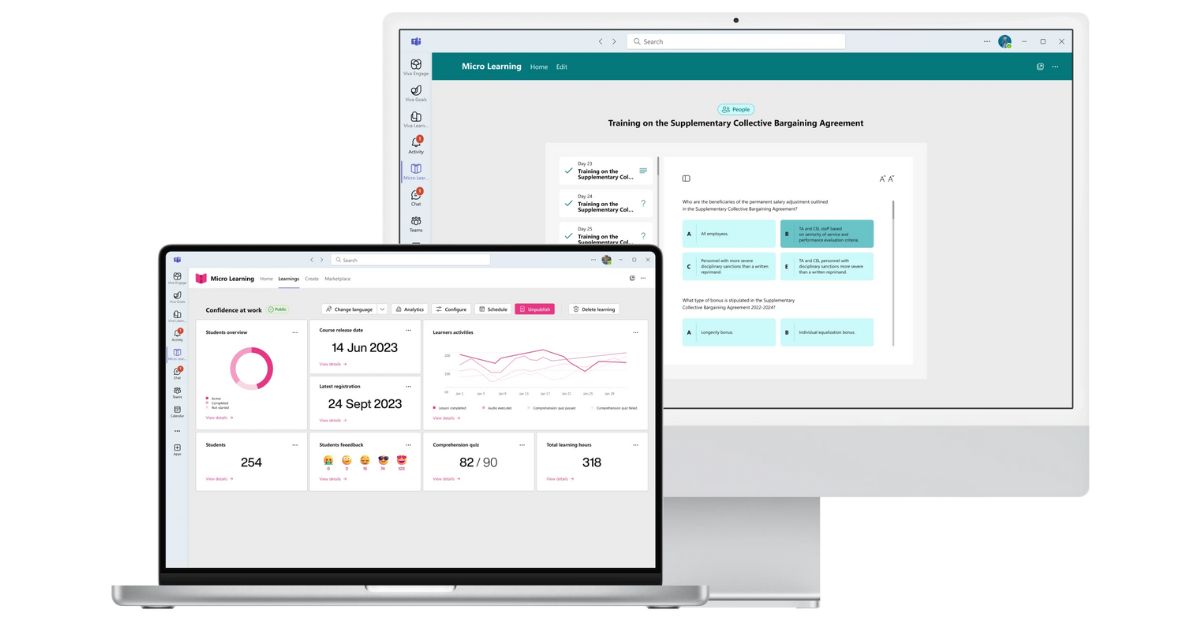
Overview of Microlearning by intranet.ai
To conclude, below is a summary table with the main benefits that the microlearning methodology — best expressed through the platform developed by our experts — offers organizations to improve the training experience of their workforce.
| Benefits of Microlearning | Description |
| Flexibility | The methodology behind Microlearning focuses on sharing small amounts of information, repeated over time, allowing users to complete short learning modules during their busy workdays. Micro-lessons are centered on specific topics and are accompanied by tests and quizzes that support concept assimilation and review. This allows people to learn new skills efficiently, without compromising their productivity. |
| Personalization | Microlearning allows training to be tailored to the constantly evolving needs of professionals and companies. Micro-lessons can be customized to address urgent gaps or provide updates on new topics relevant to the organization’s growth. AI-generated content makes training a scalable process, meeting the needs of structured and large-scale businesses. |
| Engagement | With Microlearning, the company can offer more engaging learning paths thanks to short lessons, multimedia content, and gamified experiences, keeping users’ attention high and allowing them to follow courses at their own pace, from any device and at any time of the day. |
Giuseppe Marchi
Microsoft MVP for SharePoint and Microsoft 365 since 2010.
Giuseppe is the founder of intranet.ai and one of the top experts in Italy for all things Microsoft 365. For years, he has been helping companies build their digital workspace on Microsoft's cloud, curating the people experience.
He organizes monthly online events to update customers on what's new in Microsoft 365 and help them get the most out of their digital workplace.

FAQ about microlearning
What is microlearning?
Microlearning is an innovative training methodology characterized by its brevity and accessibility. Although there is no official definition, it can be described as an approach that offers small learning units and short educational activities, typically lasting less than 5/10 minutes. This type of training is accessible via digital devices, both desktop and mobile, allowing users to absorb information with minimal effort. Learning resources can take various formats, including videos, audio, texts, illustrations, and interactive elements such as tests and quizzes.
What is the difference between e-learning and microlearning?
While e-learning focuses on structured courses that provide in-depth understanding of a topic through a linear educational path, microlearning offers small modules focused on specific learning objectives. E-learning is ideal for building a broad knowledge base, whereas microlearning is better suited for professionals and companies with limited time and energy to dedicate to training. The latter provides the flexibility to quickly learn key concepts and immediately put them into practice.
What are the benefits of microlearning?
Microlearning offers a range of significant benefits for corporate training. Its flexibility allows users to complete short learning modules during busy workdays without compromising daily productivity. Additionally, content customization enables companies to tailor training to employees’ specific needs, delivering targeted and scalable updates. Lastly, microlearning keeps users engaged through multimedia content and gamification experiences, fostering professional growth without sacrificing productivity.
How can I create effective corporate courses with microlearning?
To create effective corporate courses with microlearning, it is important to follow some best practices. It is essential to filter the information to ensure that micro-lessons do not exceed 10 minutes, thereby maximizing information assimilation and retention. Moreover, diversifying content with animations, videos, audio clips, and images helps maintain high user attention. Finally, including gamification experiences such as quizzes, tests, and challenges makes learning more interactive and engaging.
What is Microlearning by intranet.ai?
Microlearning by intranet.ai is an innovative solution that enables companies to create personalized and accessible courses and content in the microlearning format. Integrated with Microsoft 365 Copilot, this tool transforms corporate documents into short and engaging lessons, allowing users to learn quickly and efficiently. With advanced features such as automatic course generation, multilingual translation, and integration with major Microsoft applications, Microlearning by intranet.ai offers a comprehensive solution for corporate training.
Keep on reading
Cloud Digital Company: Guide to Digitalization with the Intranet



Let's see how the intranet based on SharePoint Online and Microsoft 365 can drive the digital transformation process in companies.
SharePoint Consulting: Why Choose intranet.ai?

Let's see who SharePoint Online consultants are and what they do, why it is beneficial to rely on their services and how to choose the right experts.
10 Microlearning Examples for Corporate Training



Let’s discover how microlearning improves corporate training with practical examples and our tips for creating more engaging courses.
